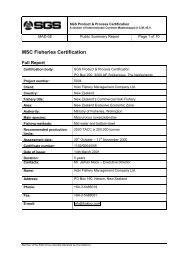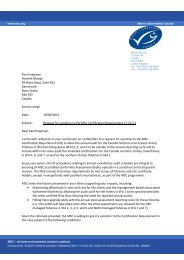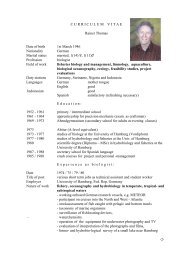SGS Product & Process Certification - Marine Stewardship Council
SGS Product & Process Certification - Marine Stewardship Council
SGS Product & Process Certification - Marine Stewardship Council
You also want an ePaper? Increase the reach of your titles
YUMPU automatically turns print PDFs into web optimized ePapers that Google loves.
Figure 3.Indices of the abundance of juvenile bass year-classes in the Thames Estuary (IVc),<br />
1994-2008 (source CEFAS).<br />
Fishery-independent estimates of relative abundance of juvenile bass year classes are also<br />
available from a trawl survey (actually using a 3-m beam trawl to sample pre-recruit flatfish)<br />
conducted in the Westscheldt Estuary (IVc) by IMARES each year, Figure 4 (source Henk<br />
Heessen, WGNEW). These also show an increasing trend in year class strength since the<br />
early 1990s, though the pattern is not the same as that in the Thames Estuary survey, probably<br />
because different age groups are used in calculating the indices (0-groups especially can suffer<br />
high mortality in cold winters).<br />
N per hour<br />
120<br />
100<br />
80<br />
60<br />
40<br />
20<br />
Figure 4. Indices of the abundance of juvenile bass year classes in the Westscheldt Estuary<br />
from the IMARES DFS (source Henk Heessen, WGNEW).<br />
3.2 Stock status<br />
Sea bass Westerscheldt<br />
0<br />
1970 1975 1980 1985 1990 1995 2000 2005 2010<br />
The results of the fleet-based separable model for the sea bass stock unit (Divisions IVb,c) that<br />
includes the southern North Sea indicate levels of F around 0.2–0.4 between 1995 and 2004<br />
(Pawson et al., 2007b). The gear selectivity patterns derived from the model confirm the results<br />
of Pawson et al. (2005).The abundance of adult bass (SSB) in the North Sea appears to have<br />
remained stable between 1985 and 2004, whilst there has been an increased level of recruitment<br />
from 1989 onwards.<br />
The patterns in F and recruitment derived from this model are consistent with the evidence<br />
provided by the CEFAS logbook scheme and the fishery-independent pre-recruit survey (which<br />
has not been used in the model), but there are inevitable problems with the scaling of F and<br />
estimating biomass. In particular, the absence of data for the recreational rod-and-line fishery,<br />
a substantial contributor to mortality on the younger sea bass, would affect estimates of<br />
recruitment to the commercial fishery. However, these are consistent between areas over the<br />
period 1984–2002, and that for VIId closely matches the fishery-independent abundance<br />
indices for pre-recruit bass provided by the Solent trawl survey that covers the main nursery<br />
areas for sea bass in Division VIId. Thus, whilst the model reflects reasonably the dynamics of<br />
the bass stock (around the UK) both in stock numbers, SSB and in F, it is not possible to<br />
Page 22 of 151





